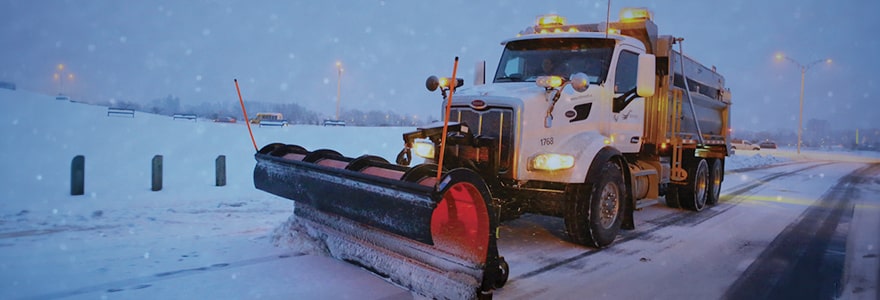Snow & Ice

How the City Prepares for Ice & Snow
The City’s winter weather response begins long before any snow begins to fall.
- Richmond stockpiles 400 to 600 metric tonnes of salt and secure access of 1,200 to 1,500 metric tonnes of salt for the calendar year, amounts based on a five-year average usage.
- All equipment is serviced, operating staff are refreshed on procedures, and new staff are trained on operating snow clearing equipment.
- Road hazards are repaired or marked for plow operations.
- Starting Nov 1, staff receive detailed daily weather reports for the next 48 hour period.
If snow is forecasted, crews start working up to 12 hours ahead, laying down anti-icing liquid brine and/or salt on the roads to prevent frost and ice from forming. As salt becomes ineffective on its own, in temperatures below –6º C, sand is added to the mix. As snow begins to accumulate, the plow blades are lowered.
Equipment
The City deploys various equipment to fight a snowstorm.
| No. | Description |
|---|---|
| 4 | Single-axle dump trucks with flinks and underbody plows |
| 1 | 1-tonne flat deck truck with insert/brine tank |
| 7 | Tandem dump trucks with insert and plough attachments |
| 2 | 1-tonne dump trucks with insert |
| 1 | Crane truck with insert |
| 6 | F550S with snow plows |
| 1 | Flusher truck (brine) |
| 4 | Mobile snow blowers |
| 4 | Backhoes |
| 2 | Front-end wheel loaders |
| 2 | Bobcat skid steers |
| 3 | Hydro excavators |
| 2 | John Deere Ride-ons with plows |
| 1 | Grader |
| 1 | Kabota with plow |
| 1 | Brine production and handling system |
| 2 | Brine applicator inserts |
| 1,050 tonnes | Salt |
What to Expect from the City during a Storm
Council Policy 7013 Roadways – Ice and Snow Removal governs the City’s response to snowfall. The policy outlines the priority routes for salting, sanding and plowing and is reviewed by staff and Council regularly.
Ice & Snow Removal Policy
Read Policy 7013 Roadways – Ice & Snow Removal to learn more.
See the Snow Response Route Map and for further information on priority routes.
Storms can happen anytime, not just between 9:00am and 5:00pm on weekdays, and City crews are ready to respond. During a storm, crews begin working around the clock in two shifts, sometimes up to 14 hours a day each, and will work through weekends and statutory holidays if required.
School Property
School District #38 is responsible for clearing snow on school property.
Sidewalks and Bus Stops
The City clears the parking lots and walkways of all civic facilities, such as community centres, as well as all major transit stops, as part of the second priority phase of snow clearing response.
Industrial Commercial and Multi-Family Property
The owners or occupiers of all industrial, commercial or multi-family residential buildings must remove all snow and ice from the sidewalk, for a distance that coincides with the property line, by 10:00am every day.
Frequently Asked Questions About Ice & Snow
Why doesn't the City plow all the streets?
Richmond side streets are not part of the 316 km of designated snow clearing and salting routes; to include them would require far greater resources than the City currently has, and Richmond’s typography, weather patterns and street design make that a less effective use of those resources. Typically, snow storms occur about 12 times per season and experience has shown that winter snow storms change to rain within a few hours or days.
Why don't you remove the snow you plow?
Our experience has been that typically the winter storms change to rain before snow removal is necessary. There is also significant cost, and a challenge to dispose of the snow in an environmentally friendly way.
Why does the City use salt?
Salt is used as the principal de-icer because it is the most readily available and most cost effective. The primary type used is rock salt mined from the earth. When salt is applied to ice and snow, it creates a brine solution that has a lower freezing temperature than the temperature of the surrounding ice.
In the 2009/2010 season, the City began to apply a liquid salt brine prior to a forecasted storm, which reduces the overall amount of salt used. Salt alone becomes ineffective, however, after –6°C, and sand is then added to then the mix.
When you plow, sometimes the blades don't take all the snow off the road. Why?
Most of our trucks are now equipped with rubber tip blades, allowing the blades to be lowered directly on the road surface. However, steel tipped blades must be kept slightly raised from the road surface to protect the drivers and the trucks. Hitting a manhole, for example, with a plow blade, even at slow speeds, could cause serious injury.
What are the hours of work for the sanding/salting/plowing crews?
During a storm, crews begin working around the clock in two shifts, sometimes up to 14 hours a day each. When a snowfall with significant accumulation is forecast, crews head out early to pre-salt the roads with liquid brine, which helps prevent ice from forming. At the end of a snow event, crews will resume their regular winter schedule of Monday through Friday, 7:00am to 4:30pm.
If I want to make a suggestion on this program, to whom do I address it?
You can mail or email your suggestion to:
City of Richmond, Roads and Construction Department
5599 Lynas LaneRichmond, BC V7C 5B2
or email pwservicecentre@richmond.ca

